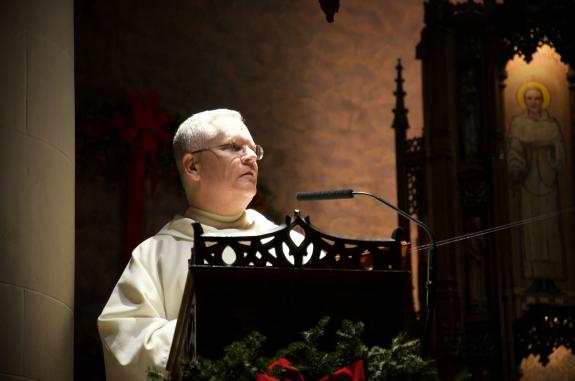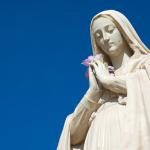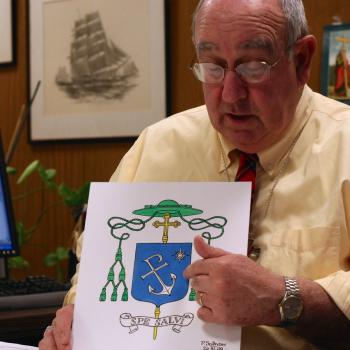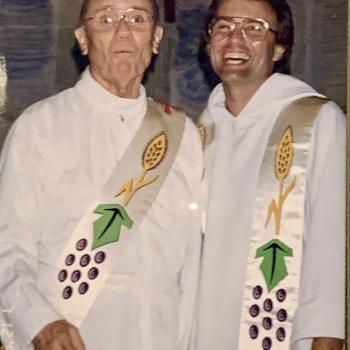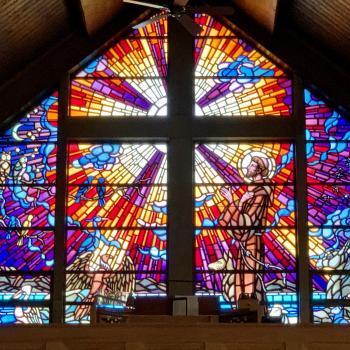Every year, it is the deacon’s privilege to announce the dates of the Church’s moveable feasts on Epiphany Sunday. It is almost a preview of the Exsultet, with some of the same musical threads. If the deacon is unavailable (or not up to it), a cantor can do it.
Here’s a great explanation and preview (using dates from a few years ago):
I know some parishes who scoff at this — “We have calendars these days, you know” — but this brief, ancient custom has a rich history and helps to remind us of our deepest roots. It also lends to the end of the Christmas season a profound and sacred sense of mystery. It reminds us not only of what has just been, but also what will be. I find it a lovely tradition.
The rubrics mandate that this be chanted immediately after you’ve chanted the Gospel. If, like me, you aren’t given to chanting the Gospel, that can seem odd and out of place. It may almost seem like a commercial interruption before the homily. The most opportune times seem to be at the conclusion of the Prayers of the Faithful (if the deacon is doing them), or at the end of Mass after the announcements and before the final blessing.
You can find the sheet music in the Roman Missal or online here.
The USCCB has this year’s dates and more:
The proclamation of the date of Easter and the other moveable feasts on Epiphany dates from a time when calendars were not readily available. It was necessary to make known the date of Easter in advance, since many celebrations of the liturgical year depend on its date. The number of Sundays that follow Epiphany, the date of Ash Wednesday, and the number of Sundays that follow Pentecost are all computed in relation to Easter.
Although calendars now give the date of Easter and the other feasts in the liturgical year for many years in advance, the Epiphany proclamation still has value. It is a reminder of the centrality of the resurrection of the Lord in the liturgical year and the importance of the great mysteries of faith which are celebrated each year.
Each year the proper dates for Ash Wednesday, Easter, Ascension, Pentecost, the Most Holy Body and Blood of Christ, and the First Sunday of Advent must be inserted into the text. Those dates are found in the table which is included with the introductory documents of the Roman Missal. The form to be used for announcing each dates is: the date of month, e.g., “the seventh day of April.”
On the Epiphany of the Lord, after the singing of the Gospel, a Deacon or cantor, in keeping with an ancient practice of Holy Church, announces from the ambo the moveable feasts of the current year according to the following text. (The musical notation is found in Appendix I of the Roman Missal, Third Edition.)
Announcement of Easter and the Moveable Feasts
(for the year 2019)
Know, dear brothers and sisters,
that, as we have rejoiced at the Nativity of our Lord Jesus Christ,
so by leave of God’s mercy
we announce to you also the joy of his Resurrection,
who is our Savior.
On the sixth day of March will fall Ash Wednesday,
and the beginning of the fast of the most sacred Lenten season.
On the twenty-first day of April you will celebrate with joy Easter Day,
the Paschal feast of our Lord Jesus Christ.
[In those places where the Ascension is observed on Thursday:
On the thirtieth day of May will be the Ascension of our Lord Jesus Christ.]
[In those places where the Ascension is transferred to the Seventh Sunday of Easter:
On the second day of June will be the Ascension of our Lord Jesus Christ.]
On the ninth day of June, the feast of Pentecost.
On the twenty-third day of June, the feast of the Most Holy Body and Blood of Christ.
On the first day of December, the First Sunday of the Advent of our Lord Jesus Christ,
to whom is honor and glory for ever and ever.
Amen.
UPDATE: I was intrigued to see this entry by my friend the Rev. Bosco Peters in New Zealand, describing what they do at his Anglican church, using two lectors. Check it out.

